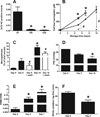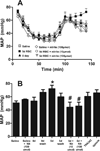Red blood cell washing, nitrite therapy, and antiheme therapies prevent stored red blood cell toxicity after trauma-hemorrhage
- PMID: 25933588
- PMCID: PMC4508223
- DOI: 10.1016/j.freeradbiomed.2015.04.025
Red blood cell washing, nitrite therapy, and antiheme therapies prevent stored red blood cell toxicity after trauma-hemorrhage
Abstract
Transfusion of stored red blood cells (RBCs) is associated with increased morbidity and mortality in trauma patients. Pro-oxidant, pro-inflammatory, and nitric oxide (NO) scavenging properties of stored RBCs are thought to underlie this association. In this study we determined the effects of RBC washing and nitrite and antiheme therapy on stored RBC-dependent toxicity in the setting of trauma-induced hemorrhage. A murine (C57BL/6) model of trauma-hemorrhage and resuscitation with 1 or 3 units of RBCs stored for 0-10 days was used. Tested variables included washing RBCs to remove lower MW components that scavenge NO, NO-repletion therapy using nitrite, or mitigation of free heme toxicity by heme scavenging or preventing TLR4 activation. Stored RBC toxicity was determined by assessment of acute lung injury indices (airway edema and inflammation) and survival. Transfusion with 5 day RBCs increased acute lung injury indexed by BAL protein and neutrophil accumulation. Washing 5 day RBCs prior to transfusion did not decrease this injury, whereas nitrite therapy did. Transfusion with 10 day RBCs elicited a more severe injury resulting in ~90% lethality, compared to <15% with 5 day RBCs. Both washing and nitrite therapy significantly protected against 10 day RBC-induced lethality, suggesting that washing may be protective when the injury stimulus is more severe. Finally, a spectral deconvolution assay was developed to simultaneously measure free heme and hemoglobin in stored RBC supernatants, which demonstrated significant increases of both in stored human and mouse RBCs. Transfusion with free heme partially recapitulated the toxicity mediated by stored RBCs. Furthermore, inhibition of TLR4 signaling, which is stimulated by heme, using TAK-242, or hemopexin-dependent sequestration of free heme significantly protected against both 5 day and 10 day mouse RBC-dependent toxicity. These data suggest that RBC washing, nitrite therapy, and/or antiheme and TLR4 strategies may prevent stored RBC toxicities.
Keywords: Acute lung injury; Heme; Hemin; Hemoglobin; Nitric oxide; Resuscitation; Storage lesion.
Copyright © 2015 Elsevier Inc. All rights reserved.
Conflict of interest statement
RPP is a co-inventor on a patent for use of nitrite salts for the treatment of cardiovascular conditions
Figures








References
-
- Weinberg JA, McGwin G, Jr., Marques MB, Cherry SA, 3rd, Reiff DA, Kerby JD, Rue LW., 3rd Transfusions in the less severely injured: does age of transfused blood affect outcomes? The Journal of trauma. 2008;65:794–798. - PubMed
Publication types
MeSH terms
Substances
Grants and funding
LinkOut - more resources
Full Text Sources
Other Literature Sources
Medical
Miscellaneous

